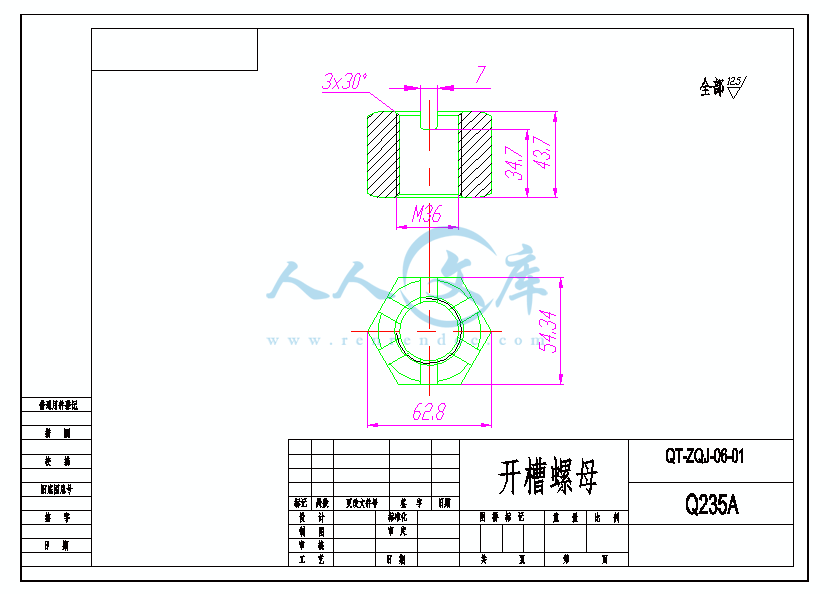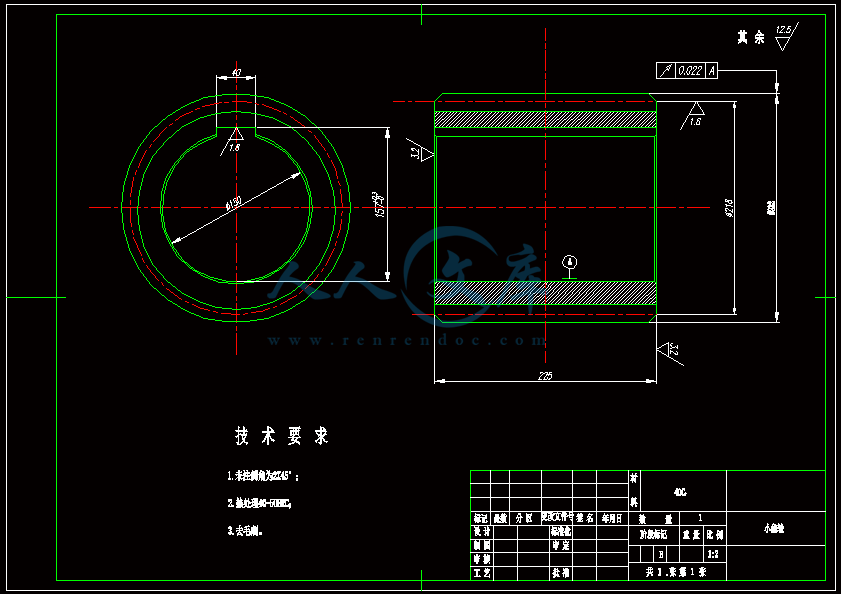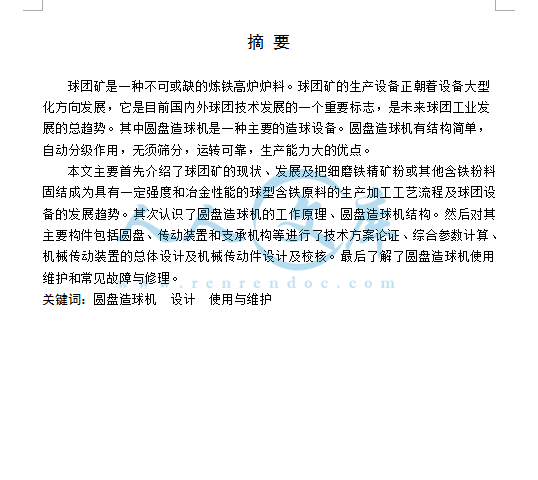球团矿CX-1型圆盘造球机设计【含CAD图纸、说明书】
收藏
资源目录

压缩包内文档预览:
编号:15055143
类型:共享资源
大小:3.80MB
格式:ZIP
上传时间:2019-02-26
上传人:机****料
认证信息
个人认证
高**(实名认证)
河南
IP属地:河南
50
积分
- 关 键 词:
-
含CAD图纸、说明书
CX-1型圆盘造球机设计
球团矿 CX-1 型圆盘造球机设计
球团矿CX-1型圆盘造球机设计
- 资源描述:
-


















- 内容简介:
-
P R O C E S S I 10/2005Memorie la metallurgia italiana33 Recycling of manganese secondary raw material via cold-bond pelletizing process Y. M. Z. Ahmed, F. M. Mohamed Large quantities of fines were produced during the shipping, transportation, handling and storage of manganese ore sinter imported from different countries to Sinai Company for ferromanganese production. These fines are generally considered as valuable secondary raw materials. Hence, they have a potential to be recycled back to the submerged arc furnace after having been agglomerated. For agglomerates to be considered as feed materials for submerged arc furnace they must have sufficient room temperature strength. Cold-bonded pelletization process offers an economically attractive and environmentally viable method for achieving this. Ordinary Portland cement was used in this investigation for the purpose of producing a suitable coldbonded pellet from such fines. In this investigation, the effect of adding different percentages of Portland cement on the mechanical properties of both green and pellet dried at room temperature for 1, 3, 7, 14, and 28 days of normal curing were studied. The results revealed that, although the compressive strength of green pellets improved with the increase of the amount of cement added, retardation in pellet drop strength was reported. Whereas, the increase in both the cement content and time of drying leads to increase in the mechanical properties of pellets normally cured at room temperature. Pellets obtained with the addition of 9% cement shows reasonable mechanical properties to be charged in the submerged arc furnace. Ferromanganese alloy having a standard range composition was produced in a laboratory submerged arc furnace using such pellets. Keywords: pelletization, manganese ore, recycling, mechanical properties, cold-bond pellet INTRODUCTION Due to the low-grade manganese ores in Egypt, Sinai Com- pany for ferromanganese production imports large quanti- ties of high-grade manganese ore sinter from different coun- tries. During the shipping, transportation, handling and sto- rage of such sinter, a large amount of manganese ore sinter fines are produced. The amounts of these fines increased an- nually with the increasing demands for ferromanganese al- loy. These fines could be considered as valuable secondary raw materials according to its high manganese to iron content (7:1), low impurities and stable chemical composition. In the mean time making use of such “waste” will solve a big environmental hazard problem to the company due to accumulation of huge amounts of these fines by time. Due to the fineness of such secondary raw material, the pel- letization process could be considered as one of the most suitable processes that deal with it. Two fundamentally dif- ferent directions of pelletizing are known: high temperature method (agglomeration and production of fired pellets) and cold-bond method i.e. without firing. Generally agglomera- tion and firing of pellets are not cost effective (capital and energyintensive) and are extremely environmentally hazar- dous, since they are characterized not only by a large amount of ordinary harmful emissions (carbon monoxide, nitrogen oxide, dust .etc) but also by super toxic dioxins and furans 1. Cold-bond pelletizing methods recently gai- ned some popularity. These are used when utilizing metal- lurgical wastes and pelleting iron, chromium and manganese materials and non-ferrous metallurgical mixtures 2. They are characterized by low capital and current expenditures, are energy saving and environmentally safe. Several investigations concerning the cold bond pelletizing process had been introduced into industrial practice 2-6. Most of these applications were interested in agglomeration of inplant fines with some waste materials like flue dust, fly ash, sludge, and other waste materials from iron and steel in- dustry. The aim of the present investigation is to produce suitable cold-bonded pellets from manganese fines using ordinary Portland cement as a binder. The effect of addition of diffe- rent percentages of cement on the mechanical properties of both green pellets and pellets cured at room temperature for different periods of time will be studied. In addition, to con- firm the viability of producing ferromanganese alloy from such pellets, suitable pellets from the mechanical properties point of view were subjected to smelting in a submerged arc furnace. Characterization of the produced alloy will be inve- stigated. MATERIALS AND EXPERIMENT Materials Manganese ore sinter fines were provided by Sinai Manga- nese Co., whereas Portland Cement Company of Egypt sup- plied the Portland cement used in this investigation. The chemical composition of both raw materials is shown in Table. 1. The received manganese ore sinter fines were subjected to a further grinding process in a laboratory ball mill for grinding the +2 mm oversize fraction. The particle size distribution of the ground product and Portland cement were shown in table 2. Experimental and Procedures The pellets were prepared in a disc pelletizer of diameter 40 cm, collar height 10 cm, angle of inclination 55 and disc ro- tating speed 17 rpm. Batches of manganese fines (500 gm of each) were thoroughly mixed with different cement percen- tages (with respect to dry weight of feed charge). The raw Y. M. Z. Ahmed, F. M. Mohamed Central Metallurgical Research and Development Institute, Cairo, Egypt Paper sent on 23 August 2004 P R O C E S S I 10/2005Memorie la metallurgia italiana34 Table 1 Chemical composition of raw materials. Tabella 1 Composizione chimica delle materie prime. Table 2 Particle size distribution of the raw materials. Tabella 2 Dimensioni delle particelle delle materie prime. mix sample was then fed to the pelletizer. The predetermi- ned water amount percentage (with respect to dry weight of the raw mix) was then sprayed onto the rolling bed of the material in the pelletizer. The green pellet in the size range 10 14 mm diameter were screened out and used in the pre- sent study. The average compressive strength of pellets was measured by compressing at least 10 green or dried pellets sample (10- 14 mm) between flat parallel steel plates up to their breaka- ge. The mean value of the tested pellets gave their compres- sive strength 7. The dropping damage resistance indicates how often green or dried pellets can be dropped from a height of 30 cm befo- re they show perceptible cracks or crumble and it measure the ability of wet pellets to remain intact during handling C. Ten green or dried pellets were individually dropped onto a steel plate until their breakage. The mean value of the tested pellets gave their dropping damage resistance 7. The produced green pellets were subjected to drying by cu- ring at room temperatures for different periods of times (1, 3, 7, 14, and 28). After each period of curing, a determina- tion of the mechanical properties of cured pellets was car- ried out. The pellets that showed suitable mechanical properties to be charged in a submerged arc furnace were, then, subjected to the smelting process. The smelting experiments for ferro- manganese alloy production were produced in a 100 KVA laboratory submerged electric arc furnace. Electric power was supplied to the furnace through AC stepwise. Transfor- mer, with primary electric power of 35 Volt and 380 Ampe- res, through 35-40 mm diameter of graphite electrodes, the electrodes can be moved up and down by a normal device. The inside dimensions of the furnace with tapping hole at the bottom, were 230 mm diameters and 200 mm depth. The furnace wall and bottom were rammed with magnesite. The nominal capacity of the furnace is 1-5 Kg ore. The furnace roof is furniture with water-cooled roof with three holes, two for the electrodes and one for charging. The technology of smelting is similar to the technology used in industry for production of ferro-alloys. RESULTS AND DISCUSSION Effect of Portland cement addition on the mechanical properties of green pellets Figures 1 and 2, show the effect of adding different percen- tages of Portland cement on both the dropping damage resi- stance and compressive strength of green pellets. It is clear that, with increasing the percentage of cement added the dropping damage resistance of green pellets decreased. On the other hand, the situation is reversed in case of pellet compressive strength. Fig. 1 Effect of cement addition on the dropping damage resistance of green pellets. Fig. 1 Effetto delladdizione di cemento sulla resistenza ai danni da caduta delle green pellets. Fig. 2 Effect of cement addition on the compressive strength of green pellets. Fig. 2 Effetto delladdizione di cemento sulla resistenza alla compressione delle green pellets. P R O C E S S I 10/2005Memorie la metallurgia italiana35 The differences in observations in case of dropping damage resistance and pellet compressive strength could be explai- ned on the light of the mechanism of rupture that took place in each test. In case of the dropping damage resistance test, the pellets were freely dropped from a fixed height several times over a steel plate up to their breakage. Accordingly, the strength of pellets against this drop is mainly dependent on the numbers and force of the liquid capillary “liquid bridge” formed between the feed particles during the pelletization process. These capillaries were formed as a result of the surface ten- sion of the liquid phase that must be added for the green pel- let formation 8. This simply means that increasing the number or/and the force of these capillaries formed between the feed particles could enhance the dropping damage resi- stance of green pellets. Since, when pellets having a sufficient number of liquid bridges dropped onto a steel plate, the pellet surface that touches the plate will be compacted internally to a certain degree and only a small pellet deformation could took place without pellet breakage. After a certain numbers of drops, the pellet will not be lon- ger having the ability for more deformation and it broke. This phenomenon could be easily observed by eye, especial- ly in case of pellet formed with the addition of large amount of liquid, which correspondingly forms a large number of li- quid capillaries between the feed particles inside the pellet. In such case, the pellet behaves like plastic since it could be dropped for large numbers and only pellets deformation without cracking or breakage took place. With the addition of Portland cement, which has high ability to absorb water, leading to decrease in the amount of water responsible for filling every voidage between feed particles, thus decreasing the number of liquid bridges, which are re- sponsible for developing pellet dropping damage resistance. This is confirmed from the same Figure 1, in which increa- sing the amount of water added from 10 to 13% at any con- stant amount of cement addition, leads to increase in the number of liquid bridges between particles and thus increase in the dropping damage resistance. In case of pellet compressive strength test, the pellet brakes as a result of layer movement inside the pellet upon each other. Here not only the number and the force of the liquid bridges between the feed particles will restrict this move- ment but also the presence of very fine particles between the grain particles will do the same. This is because the presence of large amount of fines increases the degree of compaction, which will enhance the Van Der Waals force 9, and conse- quently restrict the layer movement. The increase of pellet compressive strength with increasing the amount of cement added may be due to the fact that cement has a very small particle size compared to the particle size of the manganese ore sinter fines (as shown in Table 2), leads to increase in the degree of compaction of the formed pellet and then enhance the pellet compressive strength. It seems here that there are two factors that play a role in developing the pellet compres- sive strength: 1 - The amount of very fine particles introduced to the feed charge 2 - The number of the liquid bridges formed during pellet formation. The factor 1 seems to be dominant and more effective in de- veloping the green pellet strength. Whereas, with increasing the water amount from 10 to 13% the factors 2 plays a role in enhancing the pellet compressive strength. As shown from Figure 2, that increasing the amount of water amount added from 10 to 13% at any constant amount of cement ad- ded leads to increase in the compressive strength of green pellet. Effect of cement addition on the mechanical properties of cured pellets Figures 3 6, show the effect of different amounts of ce- ment added on the mechanical properties of pellets cured at different periods of time at room temperature. From such fi- gures it was found that, with both increase in the cement ad- dition and time of curing lead to increase in both dropping Fig. 3 Effect of cement addition on the dropping damage resistance of pellets cured at different curing periods, (water amount = 10%). Fig. 3 Effetto delladdizione di cemento sulla resistenza ai danni da caduta dei pellets con diversi periodi di stagionatura/ invecchiamento (percentuale di acqua = 10%). Fig. 4 Effect of cement addition on the dropping damage resistance of pellets cured at different curing periods, (water amount = 13%). Fig. 4 Effetto delladdizione di cemento sulla resistenza ai danni da caduta dei pellets con diversi periodi di stagionatura/ invecchiamento (percentuale di acqua = 13%). P R O C E S S I 10/2005Memorie la metallurgia italiana36 damage resistance and compressive strength of cured pellet. Also it was clear that increasing the amount of water added from 10 to 13% leads to a remarkable increase in both the dropping damage resistance and compressive strength of cu- red pellets. At any constant period of curing and at the same amount of water added, the increase of both dropping damage resistan- ce and compressive strength of cured pellet with increasing the amount of cement added may be due to the following reasons: 1 - The main components of Portland cement are alit (trical- cium silicate) and balite (basically, dicalcium silicate). On hydration they form a gluing agent, dicalcium silica- te hydrate 10, which is responsible of binding the diffe- rent particles together 9. With increasing the amount of cement added the probabilities of forming more gluing agent inside the pellets increases, which improve the me- chanical properties of the cured pellets. 2 - Portland cement can be designated as an insoluble bin- der, which probably remains uniformly, distributed th- roughout a dry pellet. It imparts strength by reducing the voidage and by virtue of its extremely fine particle size, which can be expected to increase the effectiveness of the Van Der Waals forces substantially 8. With increa- sing the amount of cement added the voidage reduction increases and further enhancement in the Van Der Waals forces between particles happens, which leads to a corre- sponding increase in the mechanical properties of cured pellets. 3 - The increase of Portland cement addition increases the degree of fineness of the whole raw mix, which increa- ses the mechanical properties of the pellet as a result of increasing the degree of compaction and number of con- tact points that imparts strength to the pellet 11. Also it was noticed that, at any constant amount of cement and water addition, the increase of the curing time leads to increase in both the dropping damage resistance and com- Fig. 5 Effect of cement addition on the compressive strength of pellets cured at different curing periods, (water amount = 10%). Fig. 5 Effetto delladdizione di cemento sulla resistenza alla compressione dei pellets con diversi periodi di stagionatura/ invecchiamento (percentuale di acqua = 10%). Fig. 6 Effect of cement addition on the compressive strength of pellets cured at different curing periods, (water amount = 13%). Fig. 6 Effetto delladdizione di cemento sulla resistenza alla compressione dei pellets con diversi periodi di stagionatura/ invecchiamento (percentuale di acqua = 13%). pressive strength of the cured pellets. This may be due to the continuous dissolution of calcium silicate with the increase in curing time resulting in precipitating of more gluing agent dicalcium silicate 10. It may also be due to the tendency for better crystallization of the hydrated products responsi- ble for strength enhancement 12. It could be noticed from the same figures that at any con- stant amount of cement addition and at any constant curing time, the increase of water addition from 10 to 13% leads to increase in both the dropping damage resistance and com- pressive pellets of cured pellets. This may be due to the fact that for developing a reasonable strength for cold bond ag- glomerate using Portland cement it is necessary to add a sui- table and sufficient amount of water. This necessity comes from the fact that, the phase responsible for developing the strength in such agglomerate, calcium silicate hydrate, (CSH) could be obtained from the reaction between calcium silicate “which is already present in Portland cement” and water. Insufficient amount of water added during pelletiza- tion of the feed charge results in formation of a lesser amount of this gluing agent inside the formed pellets. Whe- reas, with increasing the amount of water added leads to in- creasing the probability for the formation of large amount of such gluing agent inside the formed pellets. Consequently, better crystallization of such phase during different periods of curing is also responsible for strength enhancement. Production of ferromanganese alloy From the previous investigation on the effect of Portland ce- ment addition on the mechanical properti
- 温馨提示:
1: 本站所有资源如无特殊说明,都需要本地电脑安装OFFICE2007和PDF阅读器。图纸软件为CAD,CAXA,PROE,UG,SolidWorks等.压缩文件请下载最新的WinRAR软件解压。
2: 本站的文档不包含任何第三方提供的附件图纸等,如果需要附件,请联系上传者。文件的所有权益归上传用户所有。
3.本站RAR压缩包中若带图纸,网页内容里面会有图纸预览,若没有图纸预览就没有图纸。
4. 未经权益所有人同意不得将文件中的内容挪作商业或盈利用途。
5. 人人文库网仅提供信息存储空间,仅对用户上传内容的表现方式做保护处理,对用户上传分享的文档内容本身不做任何修改或编辑,并不能对任何下载内容负责。
6. 下载文件中如有侵权或不适当内容,请与我们联系,我们立即纠正。
7. 本站不保证下载资源的准确性、安全性和完整性, 同时也不承担用户因使用这些下载资源对自己和他人造成任何形式的伤害或损失。

人人文库网所有资源均是用户自行上传分享,仅供网友学习交流,未经上传用户书面授权,请勿作他用。
 川公网安备: 51019002004831号
川公网安备: 51019002004831号